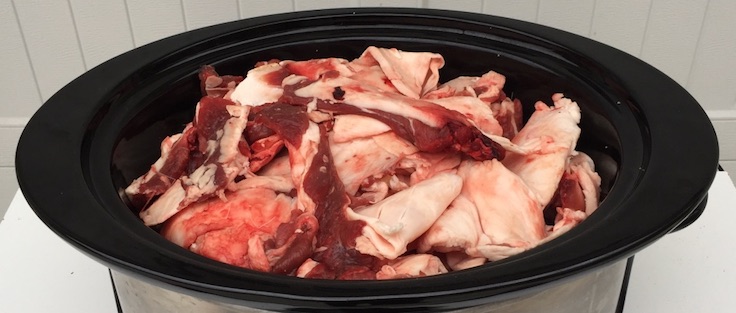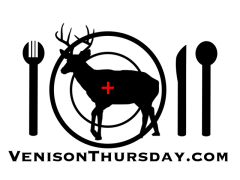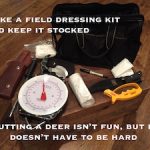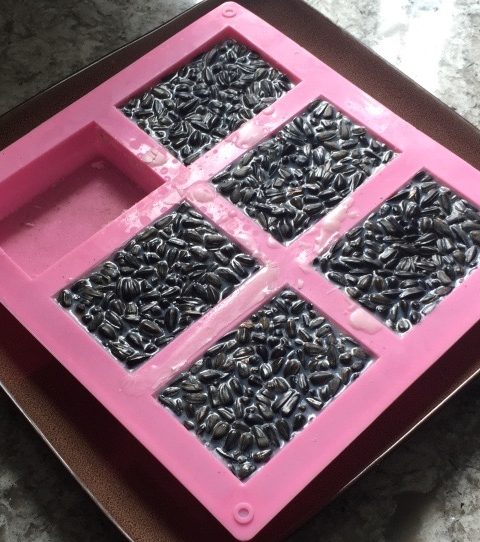
Deer fat. It doesn’t taste particularly good. To us humans anyway. Yet some deer will have a lot. I’ve pulled almost 20 pounds of almost pure fat off a large deer that seemed to be bulking up for a rough winter.
Most of the fat on a deer is used as an insulation and energy storage layer, between the meat and the hide. This makes it easy to collect once you skin the deer – this fat layer is readily exposed, and is easy to cut/peel away from the meat, especially if the temperature is cool and it has started to set up.
I keep a bag handy as I skin and butcher my deer. All bits of fat go right into the bag. You don’t get as much during the butchering part as the skinning part, but it all adds up. Even on a small deer, you’ll find you’ll get at least 5 to 10 pounds of usable fat.

You should try to get as much meat and “other” material off the fat as you can as you collect it. If the carcass is cold, the fat will be solid. If it’s a warm day and/or a freshly killed deer, it will still be very pliable, and harder to tell from some of the other connective tissue and glands.
If it’s warm, you’ll have some guess work to do, but if it’s cold the rule of thumb is: if it’s white and hard, it’s fat. Anything else can go in the discard pile.

Once you are done, you don’t have to use it right away. In fact, I prefer to toss the bag in my freezer and wait till a nice cold winter day to render it. Or until my wife yells at me that “there’s no room in the damn freezer!”. You don’t want to store it for too long unprocessed in the freezer, or it can start to get rancid. But a month or so is not going to hurt anything.
When you are ready to use it, there are two ways to go:
- Run it through a grinder.
- or, chop it up with a knife.
I prefer to grind it, because it GREATLY speeds the rendering time – the more surface area that is exposed to the fluids and heat as it cooks, the faster the fat renders out. Just one pass through a coarse blade is fine.
But sometimes I’m lazy, and will just chop it into smaller pieces with a knife – sometimes before rendering, or sometimes as it’s rendering, just cutting up the big pieces as it cooks down.
There are two things you want when rendering fat: a crockpot, and an OUTDOOR space. Rendering any fat will give off a strong odor. Do it outside, or in a garage if you have to, but do NOT cook it in the house!

Take your cut up fat, and cook it in the crockpot on high. Time will depend on many factors, including how finely you cut it and how many pounds you jammed in the crockpot. You’ll know it’s ready when it pretty much looks like cooked up chunks of deep fried meat floating in hot oil. Sometimes 8 hours. Sometimes I run it for a few days. You can turn it off and on over different days if you need to, and are concerned about running the crockpot overnight.
You want to avoid it burning. The fat will start to boil at some point, and that’s good. If the meat/gristle seems like it’s over browning, kick it down to low if it needs more time. Usually it’s about this time I pull it from the heat.
Run the results through a strainer to get the meat and other remnants out. There shouldn’t be too much water as it would have mostly boiled out. Use a METAL strainer or colander of some type. Hot fat WILL melt plastic. Along those same lines, pour it into some type of metal pot, not a plastic container.
Run the filtered liquid through the strainer again, this time with a paper towel added to more finely filter the fat. If you use a fine mesh strainer, you may not need to use a paper towel, it all comes down to how “pure” you want the suet to be. The birds aren’t going to mind. But if you want to do something different, like make soap, you will want a cleaner product.
Pour the liquid fat over any kind of birdseed to make suet. Use some type of mold, put in a layer of seed, then just fill it up till the seed is just barely covered.
I prefer silicone molds, but I have used cake pans to make giant blocks of suet. If you use something other than silicone molds, line it with wax paper or parchment paper to get it to come out easier.
If it’s cold out, put your mold out on the porch, otherwise place in the fridge or freezer till it’s solid. Once it’s fully set, you can bag it and store it in the freezer. If you got a few deer, you may have a lot of suet. I find that even if people won’t eat venison, they will readily accept pre-made suet blocks to share with the birds through the winter!



